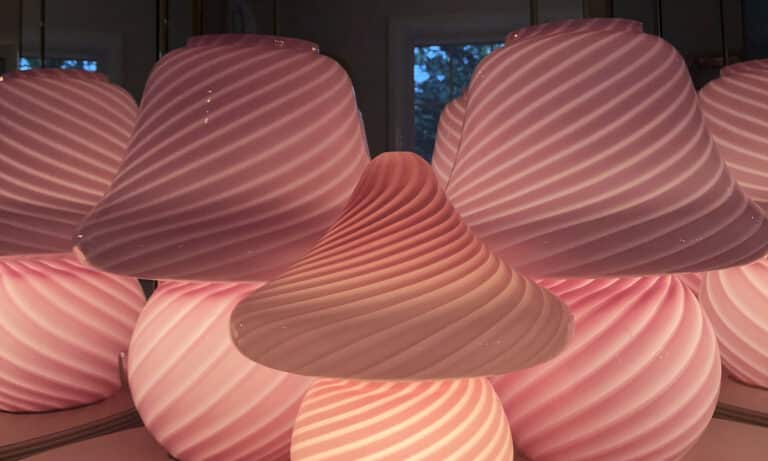Why is Instagram so obsessed with mushroom lamps?

Back in 2020, as I was riding the wave of yet another endless lockdown-induced Instagram session, I noticed that most of my favourite Scandinavian influencers—the likes of Pernille Rosenkilde and Simone Noa—had at least one mushroom lamp featured on their perfectly-curated pastel dream of a feed. Even after (albeit unsuccessfully) trying to throw off the social media platform’s algorithm by looking up influencers with other aesthetics, I noticed the same recurring element. Although not as soft-looking and somewhat lick-worthy as the former mentioned above, mushroom lamps were definitely sprouting up on my updated feed too. Italian hand-blown glass was replaced with IKEA blue or orange plastic, covered in white clouds, and even with fairycore-esque realistic fungi.
The object that Scandi influencers all went for, the Murano mushroom lamp, was definitely the most coveted one out of all the mushroom variations that appeared during COVID-19. Made of Murano glass, a specific type of hand-blown glass created exclusively on the island of Murano, located within the borders of the city of Venice in Northern Italy, the reputation that comes with this name long precedes what I like to call ‘mushroom-gate’.
Murano’s special glassblowing process is over a thousand years old, “having been re-discovered by the local artisans from the ancient Roman glassware at the end of the first millennium and continuously developed and enhanced ever since,” as stated on Glass of Venice.
Easily identifiable for its unique creations with rich colouring and beautiful, sometimes surreal, patterns and shapes, Murano glass was never cheap in the first place, which explains why, as demand for the lamps saw a surge last year, so did their prices. Soon, home décor and antique stores across the world’s biggest cities could no longer keep the vintage item in stock. Meghan Lavery, co-owner of Home Union, a vintage furniture boutique in Williamsburg, Brooklyn that has over 200,000 followers on Instagram, told New York Magazine in August 2020 that from the moment they would upload a Murano online, the lamp would sell within the hour and could go for as much as $750.
I can confirm this myself, having spent much of my lockdowns on 1stDibs trying to snatch one of those little babies for my already sufficiently lit London flat. Spoiler alert: I never did, and had to settle for an Alien-looking pink Vianne glass egg lamp originally designed by the Dutch designer Ben Swildens. Looking back on it now, I don’t regret any of it—swapping the mushroom trend for the slightly freakier egg one has allowed me to pretend that I’m not like everyone else. Emphasis on ‘pretend’.
My own shopping psychosis aside, it should be noted that TikTok also fell for the ‘mushroom craze’, thanks to fairycore, cottagecore and goblincore icons finding their own ways to implement the fleshy fungus in their home décor. Moreover, mushrooms not only took over our social media feeds, but they also managed to seep into our closets as well as our medicine cabinets.
As James Greig put it in an Another Man article titled Why Are People So Obsessed with Mushrooms?, “Whether you love or hate them, the fascination which mushrooms have exerted over humans since the dawn of civilisation is undeniable.” The presence of mushrooms in popular culture can be traced all the way back to Eastern European and Scandinavian folklore, where fungi were a common motif for mystery in fairy tales. During the 60s and 70s, mushrooms further explored the duality of reality and fantasy in everything from hallucinogens to lava lamps and even bowl cuts. Interestingly enough, Murano began producing its iconic lamp during that same time.
Heck, some people even believe that the consumption of psychedelic fungi—in other words, magic mushrooms—may have played a crucial role in the development of human mind and culture. The theory, which has since been advocated for by psilocybin mycologist Paul Stamets is now going through a revival thanks to a trending video on TikTok.
Of course, the hallucinogenic properties of certain mushrooms are an important part of their enduring cultural significance, adding a whole other element that would not be present were they simply a regular plant-like food. But only recently have they truly started to take over what seems to be the world.
In May 2020, in a Screen Shot opinion piece, Emma Latham Phillips was one of the first individuals within my echo chamber who seemed to have realised the potential mushrooms represented. She wrote at the time, “Plant-based diets are in vogue, and not only are mushrooms replacing the Big Mac, but they’re also used as leather-like alternatives, are digesting toxic waste, and are being crushed into medicinal powders.”
Meanwhile, the streetwear brand Brain Dead, which has long sold mushroom-embroidered clothing and accessories, collaborated with Maak Lab on ‘Shroom Cola’, a hyped-up line of hand sanitiser, soap, and fragrance that combined woodsy notes of mushrooms and the sweetness of Coca Cola. Shortly after that, retailers like Urban Outfitters jumped on the bandwagon with mushroom earrings, mushroom bath mats and much more mushroom-themed items.
As for the answer to why we recently all became big fans of the fungus, Francesca Gavin, curator of the 2020 Somerset House exhibition Mushrooms: The Art, Design and Future of Fungi highlighted an interesting point when mulling over the same question for The Face, “I think it’s really resonating because of climate change and a real desire to connect with nature. Mushrooms are this kind of beautiful, strange, really accessible, even childish way of tapping into our relationship with nature—that’s the thing with mushrooms, they can be metaphors for whatever you’re interested in.”
Keeping that in mind, it’s no surprise that followers of the Scandi look went from Helle Mardahl’s Bonbonniere to Murano mushroom lamps. After all, who could say no to such aesthetically pleasing interior decoration? ‘Certainly not you’ seems to scream my pink egg from the other side of my living room…





